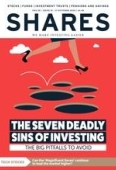Archived article
Please note that tax, investment, pension and ISA rules can change and the information and any views contained in this article may now be inaccurate.
What happens with any pension contributions in the final months before I turn 75?

I am a retired maths teacher drawing my teacher’s pension since 2010 and my state pension since 2015. I earn some more by marking GCSE exam papers and by tutoring private students.
I also have a SIPP from which I have withdrawn nothing so far. Every year I try to pay into the SIPP enough to stop me being taxed at 40%.
Next year – June 2025 – I will be 75. I know that after that I will no longer receive tax relief on payments into the SIPP. But my question is, if I make a payment into the SIPP between the start of the tax year and my birthday will I get the full amount of tax relief for the whole year? The majority of my earnings for the year will be after my birthday.
Bob
Rachel Vahey, AJ Bell Head of Public Policy, says:
To encourage us all to save for our financial later life, the government gives us tax advantages on our pensions savings. As well as receiving tax advantageous growth on our investments, we also get tax relief on the money we pay into pensions.
Although this concept is well known, it’s worth taking a step back and looking at how this works in detail.
How much pension tax relief you can get depends on your earnings and the amount of tax you pay. Also, Scottish taxpayers have different bands of tax and different rates compared to the rest of the UK, which will affect the amount of tax relief Scottish pension savers can claim.
If you are a UK resident and under age 75, you can get pension tax relief. The maximum you can pay in personally to your pensions and still get tax relief is 100% of your earnings in a tax year. If you have no earnings, you can still pay in up to £3,600 (£2,880 net) and get tax relief.
The government will give 20% basic rate tax relief on personal contributions and this money also goes into your pension. So, if you pay in £800 to your pension, the government will pay an extra £200, making a £1,000 contribution in total. Your pension provider will organise for the government to make that payment in – you don’t have to do anything.
If you pay more than 20% tax on some of your earnings – because you are a higher rate taxpayer or a Scottish taxpayer, you can reclaim extra tax relief by completing a tax return or contacting HMRC directly. Any extra relief will be returned to you or reduce your tax bill for the year – it isn’t automatically paid into your pension.
You will only get extra tax relief to the extent you pay a higher rate of tax.
Paying a pension contribution can be particularly advantageous if the level of your earnings means you have crossed into a higher tax band.
Assuming a standard personal allowance of £12,570, the income tax bands in this tax year for England, Wales and Northern Ireland are:
For example, if someone earnt £57,270, then they would pay 40% tax on the amount of income that falls within the higher rate band ─ £7,000. If they paid a pension contribution of £5,600, then basic rate tax relief of 20% (£1,400) would be added to give a gross pension contribution of £7,000.
When HMRC is working out how much tax that person pays they base it on their ‘adjusted net income’ which means deducting their gross personal contribution of £7,000 from their salary to give a figure of £50,270, and potentially avoiding higher rate tax.
Tax relief for pensions is only available up to age 75. After that age, HMRC will not pay any basic rate tax relief of 20%, and many pension providers will not accept any further contributions in.
However, you can still make tax relievable pension contributions in the tax year of your 75th birthday, right up to the date. These contributions will still be taken into account by HMRC when they are working out your ‘adjusted net income’ at the end of the tax year, and how much tax you owe and at what rate.
Important information:
These articles are provided by Shares magazine which is published by AJ Bell Media, a part of AJ Bell. Shares is not written by AJ Bell.
Shares is provided for your general information and use and is not a personal recommendation to invest. It is not intended to be relied upon by you in making or not making any investment decisions. The investments referred to in these articles will not be suitable for all investors. If in doubt please seek appropriate independent financial advice.
Investors acting on the information in these articles do so at their own risk and AJ Bell Media and its staff do not accept liability for losses suffered by investors as a result of their investment decisions.
 magazine
magazine








